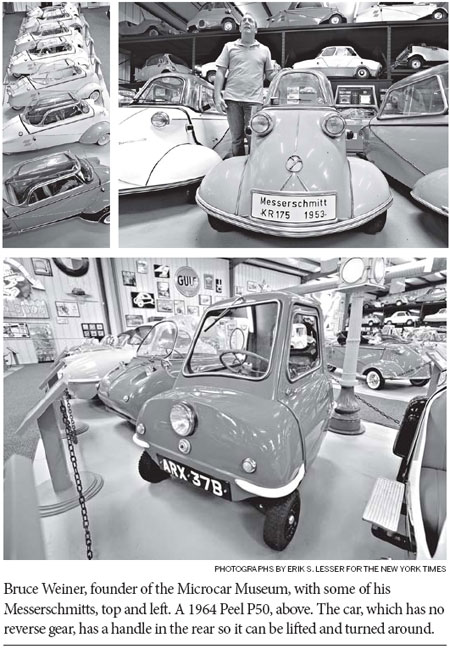Little vehicles that once moved Europe
By John Hanc (China Daily)
2010-10-24 16:46
 |
Large Medium Small |

This little car has come a long way.
Restored and repainted, it sits in a climate controlled, 7,620-square-meter American museum far from its origins on the ruined, rubble-strewn roads of postwar Germany.
The Messerschmitt KR-175 was originally built for a far-away era, when a population in dire need of transportation turned to engineering solutions to solve their problems.
The KR-175 was one of the first of a class of vehicles that would become known as microcars, defined as cars with engines smaller than 750 cubic centimeters. The KR-175 was less than three meters long and weighed 180 kilograms.
Befitting a vehicle bearing the nameplate of a company known for its fighter planes, the 1-cylinder, 9-horsepower Messerschmitt also featured a plexiglass passenger compartment dome that resembled an airplane cockpit.
It's tiny, it's fascinating, it's still futuristic looking ?and it's here with about 300 of its fellow minivehicles at the Bruce Weiner Microcar Museum in Madison, Georgia. The museum celebrates a little-known but intriguing chapter in automotive history that did not originate in the United States. Because while Americans were buying bigger and bigger cars in the late 1940s and 1950s, Europeans were thinking small.
They had little choice.
"These cars were a response to desperate conditions," said Peter Svilans, a microcar restorer and historian in Toronto. "But today they should be appreciated as a wonderful merging of technology and art."
Indeed, the flair of their designers is evident in startling features like the three wheels of the KR-175 (Messerschmitt later added a fourth), or the Italian-designed Isetta, in which the door is the entire front of the car (it opens out, steering wheel and all, and the driver climbs in).
It was also the Isetta's egglike shape that inspired the phrase by which the micros are known in some circles: bubble cars.
The flair of these vehicles is matched by Bruce Weiner, who found and brought them to the United States.
Mr. Weiner, 51, a wealthy entrepreneur, says he has been interested in cars since he was a teenager.
He said he saw a picture of a Messerschmitt in an automotive trade magazine about 20 years ago and "was fascinated. It was just so cool, so different than any other car I'd ever seen."
Mr. Weiner started collecting microcars in 1991 and has found them in barns and garages all over Europe. "With microcars, you don't just show up with a wad of cash and say sell it to me," he said. "At least not in Europe, which is where 90 percent of these cars were. There, they mean something more. It's like you showing up and asking me to sell my dad's watch."
What doomed them was economic prosperity. By the early 1960s, larger cars began to dominate the roads. "The mini completely demolished the micro," said Mr. Svilans.
Out of war's rubble, bubble cars merged art and engineering.
The New York Times